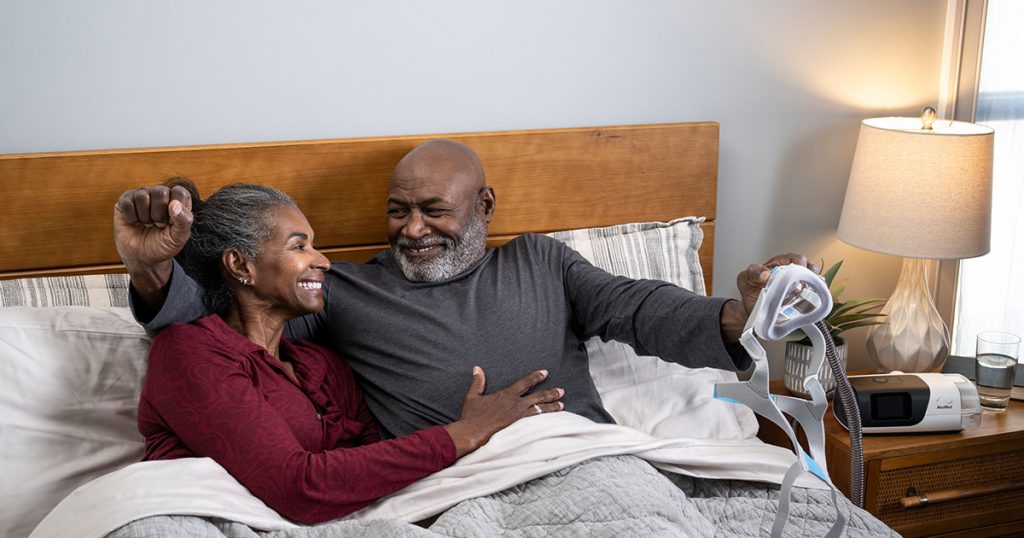
💡 Key Takeaways
- Start Slow: Introduce CPAP slowly by wearing your mask around the house during the day and napping with your machine rather than starting full-time use immediately. This gives your body time to adjust.
- Set Realistic Expectations: Initially, try to get 4 hours of sleep with your CPAP. Don’t expect perfect compliance right away, and understand that it takes most people 3-4 weeks to adjust to full-time CPAP therapy.
- Choose Equipment Wisely: Choose a mask based on your breathing style and preferred sleeping position. Experiment with the adjustable features on your machine, like heated humidification, EPR, and Ramp, to customize therapy to your comfort level. Comfort accessories like mask liners, strap covers, heated tubing, and the V-Com can help make therapy more accessible.
- Seek Community Support: Explore online forums and watch videos from others who have successfully adjusted to CPAP. Many people offer helpful tips and support online, and learning from and discussing your experiences with them can be constructive.
- Don’t Give Up: As unpleasant as CPAP therapy may be at times, remember that there are millions of people waking up every morning refreshed, clear-headed, and energized for the day thanks to CPAP. The toll untreated sleep apnea takes on your body is much worse than any discomfort CPAP can cause. You can do this.
Continuous Positive Airway Pressure is a game changer for millions of people with sleep apnea. Yet, the fear of starting CPAP therapy holds many of us back from actually treating this condition. But getting used to CPAP doesn’t have to be a miserable experience!
Recent advancements, particularly with CPAP machine comfort features, masks, and accessories, have made this process much easier. With a bit of time, patience, education, and the right resources, you can make your adjustment to CPAP therapy much easier to manage!
That’s why we’re offering a step-by-step guide on how to get used to CPAP, also referred to as CPAP desensitization, which involves slowly introducing CPAP rather than starting full-time use immediately. This gives the body and mind time to adjust. We’ll cover plenty of helpful tips below to help you transition into sleeping soundly with your CPAP machine and get you used to wearing your CPAP mask. We’ll explain the process of CPAP desensitization and how it can help you throughout your CPAP journey.
We will also discuss how long this CPAP adjustment period may last and the factors that may impact this time frame. Finally, we’ll list some of the top comfort features to look out for when choosing your CPAP machine and give you some tips for treating your sleep apnea with CPAP therapy.
How to Get Used to CPAP
Getting used to CPAP takes patience! Try introducing it in stages and practice wearing your CPAP mask while you’re awake. Learn how to use your machine’s comfort features, such as the ramp feature and humidifier. Also, check out comfort accessories like the V-Com and mask liners.
Remember, Rome wasn’t built in a day, and nobody has a perfect night of sleep on their first night with CPAP, so go easy on yourself! Below, you’ll find a list of tips ranging from advice on setting your mental state and good expectations to using your humidification properly and experimenting with helpful accessories.
1. Remind Yourself of the Importance of CPAP Therapy
Before you begin your CPAP journey, take time to learn as much as you can about sleep apnea treatment, especially with CPAP therapy. Understanding the risks of sleep apnea, the benefits of treatment, and the side effects of CPAP therapy will help you keep your mind focused on your overall goals, even if you’re having trouble adjusting.
2. Set Realistic Goals
The standard metric for gauging CPAP compliance in someone who is still adjusting to therapy is four hours of usage per night. So, even if you’re struggling to adapt or find yourself ripping your mask off at 2 AM, just remember that you only need to hit four hours a night during your adjustment period. Setting realistic expectations here is crucial to keeping up the minimum of therapy while you’re still figuring things out, so cut yourself some slack if you’re not sleeping through the whole night with your CPAP just yet!
3. Learn About Your CPAP Equipment
Take time to familiarize yourself with your CPAP equipment and machine settings. Newer machines often offer comfort features, such as your ramp feature and EPR settings, which both work to make the continuous pressure of CPAP more tolerable and easy to adjust to. One great way to learn more about your CPAP machine or mask is to read reviews and watch video content from trusted sleep apnea health experts, CPAP suppliers, or CPAP owners.
4. Find Support From Other CPAP Owners
Sharing experiences and seeking advice can be helpful during the desensitization process. There are many great content creators in the YouTube space, like CPAP Reviews and TheLankyLefty27, who are dedicated to providing unbiased, actionable information that’s digestible for CPAP beginners. You can also join CPAP forums, as they allow you to speak more directly with others who are experiencing many of the same things. CPAPtalk.com and Apnea Board are both excellent resources that we highly recommend.
5. Make Sure You Have the Right CPAP Mask
Your CPAP mask can make or break your CPAP treatment, so choosing a mask that fits well and is comfortable for you is the most important aspect of therapy! Consider factors like facial shape, pressure settings, sleep position, and skin sensitivities. Traditional nasal masks and nasal pillows are often suggested for new CPAP owners and side sleepers, while full face masks are often a good option for people who breathe through their mouth or require high-pressure CPAP therapy.
6. Desensitize Yourself to Your CPAP Mask and Machine
CPAP therapy is a marathon, not a sprint! It’s okay to start slow. In fact, most experts encourage this approach, calling it CPAP desensitization. When you first begin, try wearing your CPAP mask or using your CPAP machine while awake or during daytime naps. Increase the duration gradually, adding more time each night until you can use it comfortably and get a good night’s sleep. We’ll talk more about CPAP desensitization in just a moment!
7. Adjust Your CPAP Mask Fit
We cannot overstate the importance of a good CPAP mask fit. A good mask fit limits air leakage and even reduces your risk for CPAP skin irritation. Many factors go into getting your mask to fit correctly, such as selecting the right mask cushion size and making adjustments to secure your headgear without overtightening.
While sizing guides can help, we highly recommend buying a Fit Pack with any new mask. Fit Packs include all available cushion sizes, so even if the sizing guide says you’re a medium, you might actually get better therapy or a stronger seal with a small or large cushion; having those cushions on hand to experiment with is the best way to be sure your mask fits as well as it can.
8. Try a V-Com and Other CPAP Comfort Accessories
There are several CPAP accessories that can make adjusting to CPAP so much easier. One of the most exciting new advancements is the V-Com, which reduces much of the discomfort when you are learning to breathe against the flow of pressurized air. Other popular comfort accessories include CPAP mask liners which add comfort and help reduce mask leaks, headgear strap pads to add a softer touch to your mask’s frame, and heated tubing that helps you get the most out of your humidification.
9. Practice Relaxation Techniques
If you find it challenging to fall asleep or become anxious while using your CPAP, try relaxation techniques such as deep breathing, meditation, or guided imagery. These techniques promote relaxation, reduce anxiety, and get your mind off of the discomfort you may be feeling.
10. Use Moisture and Heat
CPAP can dry out our mouth, nose, and throat and even cause nasal congestion. Drinking water to stay hydrated may help some, but learning how to use your machine’s heated humidifier is probably the most effective solution to CPAP dryness. Your doctor may also suggest using throat spray, sore throat drops, nasal saline spray, nasal decongestant, or even a bit of lanolin or aloe vera inside your nose to reduce dryness and discomfort.
11. Block Out CPAP Noise
Most recent CPAP machines and masks are designed to be quiet, but falling asleep to even the slightest sound of airflow can take some getting used to. Keep your CPAP machine and equipment clean and replace your parts on schedule. Dirt and debris can build up and can create extra noise. If you are still struggling with the noise, invest in some noise-blocking products like earplugs or a white noise machine.
12. Try Different Sleeping Positions
Did you know there is a “best” sleeping position for sleep apnea? While many of us sleep on our backs, experts suggest that people with Obstructive Sleep Apnea try side sleeping to improve sleep apnea severity and make breathing easier. Laying on your side may help you feel more comfortable and less confined while using your CPAP machine. If you can’t lay on your side, try sleeping at an incline on your back.
13. Track How Well You’re Responding to CPAP Treatment
It’s important to track how your sleep apnea responds to CPAP treatment, even during this adjustment period. Document any changes to sleep quality and improvements in your typical day-to-day signs of sleep apnea such as your overall alertness, energy levels, and mood regulation. Check your machine’s CPAP usage report for concrete numbers, like how many sleep apnea episodes and mask leaks you experience.
Keep in mind there are CPAP machines that track your data and wirelessly sync to a companion app, which can help you better understand how your body is responding to your sleep apnea treatment plan. Some of our favorite machines with this feature are the AirSense 10 AutoSet, AirSense 11 AutoSet, and Luna G3 Auto CPAP.
14. Stick to a Consistent Bedtime Routine
While it may not be the first thing you think of when getting used to CPAP therapy, your bedtime and routine are very important for therapy success. Indeed, science has shown that an inconsistent bedtime routine and untreated sleep apnea impact the body in very similar ways.
As it pertains to CPAP therapy, specifically, a 2014 study found that those who had a bedtime window that varied by 75 minutes or more were 3.5 times more likely to be non-compliant with CPAP compared to those who had more consistent bedtimes.
In short, keeping a more consistent bedtime drastically increases your chances of enjoying the benefits of successful CPAP therapy.
15. Talk to Your Healthcare Provider
If you have any concerns about your progress or feel you aren’t acclimating, do not be afraid to contact your doctor for more personalized guidance. In some cases, your doctor may suggest trying a sleep aid to help you fall asleep with your CPAP machine. Our expert customer service team also knows a thing or two about the best ways to adjust to therapy, so don’t hesitate to reach out to us, either!
What Is CPAP Desensitization?
CPAP desensitization involves gradually introducing a person to CPAP therapy. The goal is to help the individual become more comfortable and tolerant of the ins and outs of therapy over time, ultimately improving compliance and overall sleep quality.
So, why do experts suggest CPAP desensitization? To be honest, Continuous Positive Airway Pressure can be tough to get used to. Unfortunately, a lot of people quit early. Some studies have even estimated that up to 50% of people who begin CPAP therapy will quit treatment within the first week.
While the health benefits of regularly using your CPAP machine are clear, you shouldn’t force yourself to have perfect compliance on day one. In fact, insurance companies usually ask that you sleep with it for at least 4 hours per night, 21 nights out of the month. So it’s okay to work up to sleeping with your CPAP equipment full-time!
How to Practice CPAP Machine Desensitization
CPAP machines deliver a constant and steady flow of pressurized air to your airway, which keeps the airway open and reduces the number of sleep apnea episodes. Some individuals find this sensation uncomfortable and may even feel they cannot breathe as effectively.
Initially, we suggest using your CPAP machine while you are awake for an hour or so during the day or before going to sleep. It may be helpful to distract yourself by watching TV or reading a book in bed during these practice sessions.
Many people start by sleeping with their CPAP machine only during short naps, then transitioning into using it at night after a couple of days. Once you begin to sleep with it at night, aim to use it for a couple of hours at a time. After a few days, push that timeframe to four hours a night. Eventually, you can move to full-time!
How to Practice CPAP Mask Desensitization
One of the most common complaints about Continuous Positive Airway Pressure is CPAP mask discomfort, which can cause some people to feel claustrophobic. This issue is usually due to the stress response that is triggered when an object or material covers your mouth and/or nose.
Your healthcare provider will most likely encourage you to choose a mask that covers as little of your face as possible. For example, if you can breathe through your nose with low to moderate air pressure requirements, you will most likely start with a nasal pillow mask because it covers a much smaller portion of your face yet maintains a strong seal.
If you’re struggling with feeling claustrophobic in your mask, try wearing it around your house for short periods during the daytime. Because your CPAP mask can be worn without being attached to your CPAP device, you can walk around, watch TV, and even do some household chores.
Before bed, try wearing your mask for fifteen or twenty minutes before turning your CPAP machine on. And once you do turn your machine on, spend a few minutes deep breathing through your mask before lying down.
How Long Does it Take to Get Used to CPAP?
If you’re getting used to CPAP, don’t throw in the towel after only a few attempts! Insurance companies give you 90 days to prove you will use your CPAP for at least four hours a night, five nights a week. However, most people adjust to full-time use within three to four weeks.
There are a few factors that can influence the CPAP adjustment period.
- Mask Comfort and Fit: If the mask is uncomfortable or doesn’t fit properly, it can make it much harder to adjust due to air leaks, noise, discomfort, and decreased effectiveness.
- Pressure Settings: Higher pressure settings may be harder to get used to than low air pressure prescriptions.
- Sleep Environment: Noise, temperature, lighting, and overall comfort in your bedroom can impact how quickly someone adjusts to using CPAP.
- Education and Support: Having access to the right information and support from sleep apnea experts can make adjusting to CPAP much easier.
- Individual Tolerance: Some people adapt quickly and find relief from their sleep apnea symptoms within a few days. Others may take weeks or a couple of months.
- Sleep Apnea Symptoms: The more impacted you are by sleep apnea, the easier it is to see the benefits of CPAP right away, making it easier to transition into using your CPAP.
CPAP Machine Comfort Features Can Help You Adjust to CPAP
CPAP devices have come a long way since the early days. Current manufacturers often prioritize machine features that increase comfort and reduce annoying CPAP side effects. Here are some comfort features to keep an eye out for when choosing your CPAP machine!
- Ramp Function: The ramp function allows your CPAP device to gradually increase your air pressure at the beginning of each therapy session.
- Expiratory Pressure Relief: Most CPAP machines offer some form of Expiratory Pressure Relief, which temporarily lowers your air pressure level each time you breathe out. EPR makes it easier to exhale during CPAP therapy. Depending on your machine’s manufacturer, this feature will have a different name, such as EPR, IPR, EZEX, Reslex, FLEX, A-Flex, C-Flex, SensAwake, or Z-Breathe.
- Heated Humidification: Heated humidifiers are fairly common with newer CPAP machines and reduce your likelihood of waking up with a dry mouth, sore throat, or nasal dryness.
- Automatic Pressure Adjustment: Often called Auto-CPAP machines or APAPs, these CPAP devices automatically adjust the air pressure produced based on your specific breathing patterns. Most APAP machines also have the ability to run in fixed-pressure CPAP mode and can be easily changed between the operating modes in the settings menus.
- Quiet Operation Technology: Many new-generation CPAP machines limit the amount of noise your CPAP machine creates. Air blowers have gotten quieter with each generation, and some machines even include built-in vibration dampening and tube mufflers, like the Transcend Micro Travel CPAP.
Tips For Treating Sleep Apnea With CPAP Therapy
Here are some CPAP machine tips to help you get the most out of CPAP therapy!
- Stay Consistent: Before starting CPAP therapy, commit to giving yourself time to adjust. It’s okay to take breaks occasionally if you’re struggling to get good sleep with your CPAP. But ultimately, consistency is key to getting used to CPAP.
- Keep Your Equipment Clean: Clean your CPAP equipment regularly with mild soap, water, and/or vinegar. For more information about cleaning your CPAP tubing, hoses, humidifier, mask, machine, and more, check here!
- Create a Comfortable Sleep Environment: It’s easier to adjust to CPAP if you can quickly fall and stay asleep. Creating a comfortable and cozy sleeping environment can help you fall asleep faster, even with your CPAP machine running.
- Replace Your CPAP Parts On Schedule: Your CPAP equipment also needs to be replaced from time to time. Check out our equipment replacement schedule here!
Frequently Asked Questions About Getting Used to CPAP
What Is the Best CPAP Mask For Beginners?
If you can breathe through your nose and do not require high-pressure CPAP therapy, most sleep apnea experts suggest starting with a nasal pillow mask because they are less likely to cause claustrophobia and make you feel like you are choking on air. Determine what masks cater to your breathing style (nose only, mouth only, or combo) and your sleeping style (back, side, stomach, or active sleeping), then start with whatever mask makes the least contact with your face for the best chance at therapy success.
Related Reading: Best CPAP Masks Compared & Reviewed
How To Treat Obstructive Sleep Apnea If You Can’t Get Used to CPAP?
CPAP therapy is the gold standard treatment for Obstructive Sleep Apnea. However, some people may benefit from other types of sleep apnea treatment, including Oral Appliance Therapy, Positional Therapy, Lifestyle Changes, and Surgery.
Why Is It So Hard to Breathe With CPAP?
It can be confusing to experience trouble breathing with CPAP. Isn’t it supposed to make breathing easier? Technically, it does, but the pressurized air pushing into your airway can make you swallow air accidentally and feel like you are fighting to breathe normally, especially when you are exhaling.
How to Breathe Easier With CPAP?
It can be especially difficult to breathe out against incoming CPAP pressure, which is why most machines include some form of pressure relief function that lowers incoming air when you’re exhaling. Locate your machine’s pressure relief setting and start with a setting of 1 to see if that helps. If not, increase the setting to 2 or 3 as needed, but know that pressure relief set too high can impact your therapy, so use it sparingly. Your machine’s ramp function can also help make it easier to breathe normally as you fall asleep.
How Long Does It Take to Get Used to a CPAP Mask?
This depends on the person, the mask, and the air pressure. If you are not claustrophobic and use low air pressure, you will likely adjust within the first couple of weeks. In other cases, it may take a month or more to find the settings and products that work for them.
Final Thoughts
Getting used to using a CPAP machine and mask takes time, but it’s never impossible! It’s important to begin this process with the mindset that CPAP therapy will make a long-term difference in your life. Go at your own pace and take advantage of the comfort features, accessories, and other CPAP solutions available to you. Prioritize getting healthy sleep, and don’t hesitate to reach out if you’re struggling!
For more information on CPAP machines, masks, accessories, and more, contact the CPAP experts today at CPAP.com!



